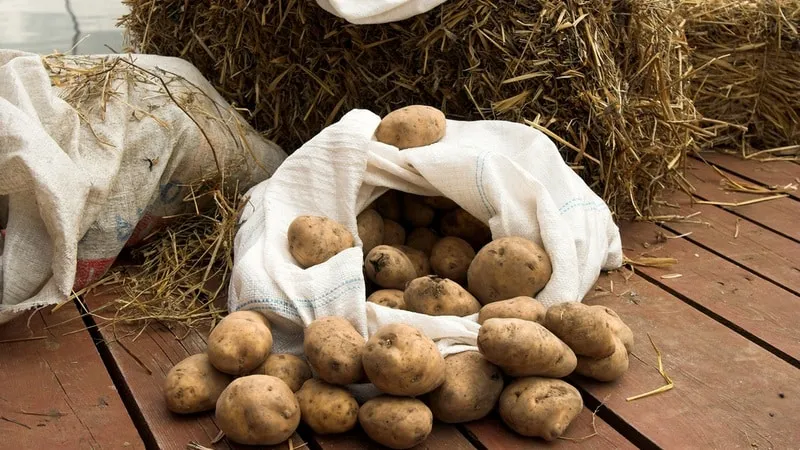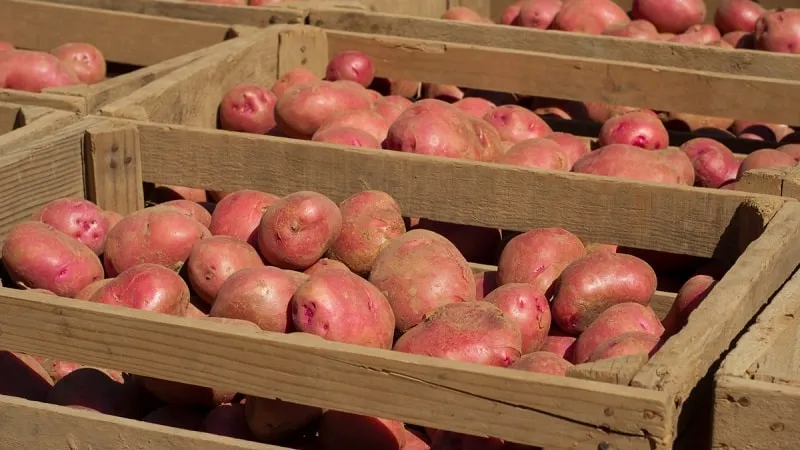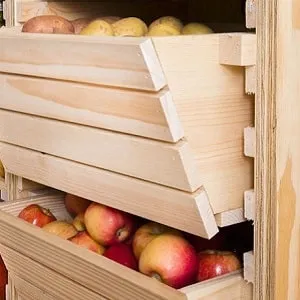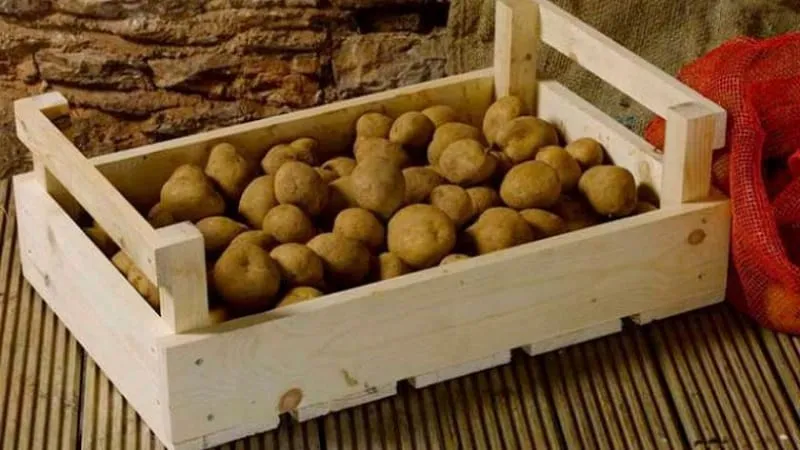Potatoes are one of the most frequent guests on our tables. To enjoy high-quality vegetables all year round, it's essential to store them correctly. The harvest can be kept not only in a cellar but also in an apartment: in the hallway, pantry, on the balcony, in the kitchen, or in the refrigerator.
To prevent tubers from rotting or sprouting, they need optimal conditions: temperature, humidity, and air circulation.
Table of contents
Harvesting Times for Winter Storage
Only fully matured tubers store well. The signal for harvesting is when the leaves begin to dry. Experienced gardeners wait about a month until the foliage completely withers. Potatoes should be dug up only on sunny and dry days to minimise the risk of future rot.
Early varieties are harvested in late July – early August, mid-season varieties by the end of summer, and late varieties from late August to the first weeks of September.

Preparation for Storage
Preparing potatoes is crucial and involves several steps:
- After digging, spread the tubers in a single layer on a polyethylene sheet outdoors and let them dry for about a day. This eliminates microorganisms and removes excess moisture.
- Clean the potatoes thoroughly from soil and sort them. Separate mouldy, insect-infested, or mechanically damaged tubers from healthy ones. Sort by variety to account for different storage durations. Early varieties should be used first.
- Place the harvest on a tarp under a canopy and let it dry for another day.
After this, the vegetables are packed into crates or bags for winter storage.
Optimal Storage Conditions
To keep potatoes edible for as long as possible, follow these guidelines:
- Ensure pests (rats, mice, insects) cannot access the storage area;
- Maintain an optimal microclimate (+2…+4°C, 75–80% humidity);
- Use wooden crates with padding, mesh bags, or canvas sacks for storage;
- Inspect the tubers every 1–1.5 months.
Storing in the Refrigerator or Freezer
While keeping potatoes in the fridge is convenient and simple, fitting the entire harvest on the shelves is impractical. Additionally, low temperatures and condensation can negatively affect the taste of the tubers.
How Long Can They Last?
The shelf life of potatoes in the refrigerator is short, around 5–10 days. It's best to store them in small batches of 2-3 kg, which can be consumed within about 1.5 weeks.
In the freezer, fried or boiled potatoes last 10–15 days, while whole or sliced potatoes can be stored for 3–6 months.
Best Storage Forms
Raw potatoes can be kept in the vegetable drawer for up to a week. Before storage, check for damage and clean off any soil.
 Peeled potatoes darken quickly when exposed to air. To extend freshness, follow these steps:
Peeled potatoes darken quickly when exposed to air. To extend freshness, follow these steps:
- Rinse the tubers and place them in a container of cold water. At room temperature, this extends shelf life by 4 hours; in the fridge, by a day.
- Wash and dry thoroughly with paper towels, then place in vacuum-sealed bags, seal tightly, and freeze.
Boiled potatoes last 3–4 days in the refrigerator.
Important! In prepared dishes, potatoes should not be stored for more than 2 days.
Why Refrigeration Isn’t Ideal
Although cold is essential for preserving many foods, it harms potatoes in the long term:
- At low temperatures, starch converts into sugar, giving potatoes a sweet taste;
- Condensation from warm air causes tubers to become damp and rot.
Best Refrigeration Practices
Store potatoes in the fridge’s vegetable drawer at +5°C. For freezing, blanch them first by dipping in boiling water, then ice water, drying with paper towels, and packing into containers.
Tip! To freeze fried potatoes, cool them completely and blot excess oil with paper towels.
Storing Potatoes in an Apartment
Without a cellar, the harvest can be kept in an apartment until spring.

In the Hallway
While storing potatoes indoors ensures easy access, fluctuating temperatures pose a challenge.
Hallway temperatures vary, and cold drafts from opening doors can affect the tubers. Dirt and water from shoes and umbrellas are additional risks.
Maintain humidity at 75–80%. Cover potatoes with burlap to prevent sweating. In warm apartments, place a water container nearby to regulate humidity.
In the Building’s Common Area
Storing potatoes in a shared hallway allows for larger quantities, but theft is a concern. Secure crates with locks or anchor them to the floor.
Important! Winter emergencies like pipe leaks can damage stored potatoes.
At Room Temperature
Room temperature is unsuitable for long-term storage: it exceeds the ideal +2…+4°C, leading to rot, drying, or sprouting. Shelf life in such conditions is 10–14 days.
In the Pantry
 How to store potatoes in an apartment? A pantry is the best option: it maintains stable conditions and blocks sunlight.
How to store potatoes in an apartment? A pantry is the best option: it maintains stable conditions and blocks sunlight.
Tubers won’t sprout, turn green, or rot. Store them in wooden crates with ventilation holes or mesh bags.
If the air is too dry, increase humidity to 75–80% using a spray bottle, damp cloth, or an open water container.
In the Kitchen
Due to limited space, potatoes are often stored under the sink. The main advantage is proximity to cooking areas. However, plumbing leaks and pests can spoil the harvest.
Important! Ensure proper ventilation under the sink.
Store potatoes in wicker baskets or ventilated wooden crates.
On the Balcony
Balconies are a common storage spot. Large crates can be placed here, and stable temperatures keep potatoes fresh until spring.
Choosing the Right Balcony
 Even glazed balconies get cold in winter, especially during January frosts, so heated spaces are preferable. Thermometers help maintain the ideal microclimate (+2…+4°C).
Even glazed balconies get cold in winter, especially during January frosts, so heated spaces are preferable. Thermometers help maintain the ideal microclimate (+2…+4°C).
Open balconies lack suitable conditions — tubers are exposed to temperature drops, so glazed spaces are better.
How Long Do Potatoes Last?
With proper temperature, humidity, and ventilation, potatoes stay fresh until spring. Otherwise, they last only 1–2 months, until autumn rains begin.
Extending Shelf Life
To keep potatoes fresh until spring, follow these tips:
- Maintain a temperature of +2…+4°C. Higher temperatures cause sprouting; lower ones lead to freezing.
- Keep humidity at 70–85% to prevent rot.
- Ensure good ventilation in the storage area.
- Shield tubers from light: sunlight triggers the production of solanine, a toxic compound. Discard green potatoes immediately.
- Line the storage container with sand to absorb excess moisture.
Best Storage Containers
How to store potatoes in an apartment? Depending on conditions, use crates or mesh bags.

Wooden Crates
Unheated crates work well in apartments, basements, or insulated balconies. Wooden crates provide ventilation and prevent moisture buildup.
Crates can be homemade from spare wood or purchased ready-made.
Useful Tip! Insulate crates with polystyrene, foil, or thick fabric to protect against cold, but ensure ventilation isn’t compromised. Check tubers regularly for dampness.
Specialised crates with temperature control are available. They’re more expensive but guarantee fresh potatoes until spring.
Plastic Crates
These are affordable but lack ventilation. Plastic is synthetic and traps moisture, creating a greenhouse effect.
Drill small holes in the crate walls and line the bottom with sand or straw to improve airflow.
Important! Avoid using plastic crates outdoors or in shared hallways.
Other Methods
For warm storage spaces, use mesh bags.
For balconies, thermal containers (insulated backpacks) with foil lining are ideal. Some models include heating elements for unheated balconies.
Common Mistakes

When storing potatoes at home, avoid these errors:
- Insufficient sorting. Remove damaged tubers; only store healthy ones.
- Storing with incompatible vegetables. The best companion is beetroot, placed on top to absorb excess moisture.
- Skipping container disinfection. Treat crates and bags with a potassium permanganate solution.
Expert Tips
Additional advice for long-term potato storage:
- Place mint or cloves in the crate to deter pests;
- Use straw instead of fabric for insulation;
- Don’t mix early and late varieties—early ones aren’t suited for long storage;
- Spruce branches or wormwood between tubers prevent rot.
Conclusion
Keeping potatoes fresh through winter is simple with the right approach. While cellars or basements are ideal, a well-regulated pantry or insulated balcony can preserve tubers just as effectively until spring.







